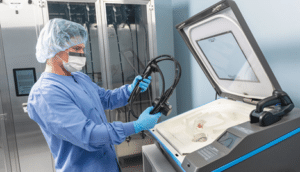 Due to various, well-publicized episodes over the last decade, endoscopic procedures continue to be scrutinized as a potential source of superbug outbreaks within hospitals. In the current environment, where patient safety and infection control are at the forefront of most hospital administrators, endoscopy may receive a closer look to see what can be done to reduce risk to patients.
Due to various, well-publicized episodes over the last decade, endoscopic procedures continue to be scrutinized as a potential source of superbug outbreaks within hospitals. In the current environment, where patient safety and infection control are at the forefront of most hospital administrators, endoscopy may receive a closer look to see what can be done to reduce risk to patients.
Endoscopy departments and outpatient centers tend to be very busy environments, requiring a constant cycle of endoscope use and reprocessing to keep up with scheduled procedures. Lack of scope availability can create tension between department managers and cleaning technicians, making a well-planned and properly staffed sterile processing department critical. This article by Gina Shaw at Gastroenterology & Endoscopy News discusses the sometimes-opposing forces of reprocessing turnaround times and reprocessing quality:
“The biggest issue we see with endoscope reprocessing is a lack of inventory and staff having wicked production pressure to turn these scopes over. Do you have enough equipment to support patient loads, or are you forcing staff to continually be reprocessing all day long, eight to 10 hours a day, because you don’t have enough inventory of the correct scope?” asked James Davis, MSN, RN, a certified health care environmental manager and senior infection prevention analyst at ECRI Institute. “If you have one ECRP scope and 16 of those procedures scheduled that day, what’s going to happen?” Mr. Davis added. “In that scenario,” he explained, “you’re more apt as a human being to make mistakes and contaminate yourself and the scope. The people at the top need to understand that the whole process, from leaving the bedside through reprocessing to hanging in the cabinet ready for use doesn’t take five minutes if you’re doing it right. If you are properly following the instructions for use (IFU), depending on the process and reprocessing equipment, it can take hours or more to do certain scopes properly.”
Reprocessing Continuum Starts at the Bedside
In the Division of Digestive Diseases at the University of Cincinnati Medical Center, the reprocessing cycle typically takes approximately 40 minutes, although that varies based on the complexity of the scope, according to gastroenterologist Milton Smith, MD. “The most important part starts at the bedside after the procedure,” he stressed. “It’s so important to do enzymatic bedside cleaning before any debris can dry on the scope. Then our computerized system takes about 30 to 40 minutes to run a scope through.”
To ensure there is no issue with running out or falling behind and putting pressure on the reprocessing team, the department maintains an inventory of about 80 scopes, including specialty scopes, for its caseload of 25 to 30 patients per day.
“We reprocess our own scopes right here on the endoscopy unit,” said nurse manager Michelle Armstrong. “The reprocessing facility is centrally located to all procedure rooms, and it has a ‘dirty’ and ‘clean’ side, with everything flowing from dirty to clean. The tech starts on the dirty side and does all their manual cleaning before loading the scope washers up. Once that is done, they move to the clean side: the drying and blowing out process and hanging in the closet for storage.”
Mr. Davis recommended that institutions regularly audit their reprocessing system—a continuum that starts from the moment the procedure is completed. “The process should be seamless from that moment, beginning with immediate manual flushing to prevent a bioburden from setting up on the scope. Are the staff flushing the scope initially with the right enzymatic cleaner to break down proteins and biological material? Then, as they are transferring the scopes to the washer, are they doing so without contaminating the washer lid? Are they using the proper alcohol and air flushes when the scopes come out of the washer? Are they hanging in the cabinet the right way—not looped so fluid is collecting, or with tips touching the bottom of the cabinet? We’ve seen scopes rolled up like garden hoses, channeling fluid where contamination will grow.”
Read the entire communication here: Is Production Pressure Contributing To Scope Cleaning Gaps?
In order to keep patient safety at the forefront of their operation, endoscopy and perioperative departments must design a standard protocol that ensures the highest quality disinfection of endoscopes while maintaining a quick turnaround. Hospitals must also implement systems and processes that allow them to check that staff are following their protocols and documenting their steps for regulatory purposes, such as Joint Commission surveys. Systems such as iRIScope can display the proper workflow for reprocessing endoscopes and document the individual steps automatically. Any breaches of protocol can be alerted in real-time to protect patients and identify which staff members need additional training on reprocessing techniques. Having a system like this in place ensures that staff are following all required reprocessing steps each time, while providing the constant data feedback that will allow you to continuously improve turnaround times.
